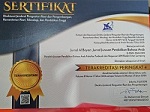The Correlation between Language Skill and the Brain in the Second Verse of Surah Yusuf l ‘Alaqah al-Maharah al-Lughawiyyah wa al-‘Aql fi Surah Yusuf al-Ayah al-Tsaniyyah
Abstract
Keywords
Full Text:
PDFReferences
Agustin, Karunia Kholifah Dini. “Analisis Semantik Kata Dla‘īf dalam Surah an-Nisa Ayat 28 dan Surah ar-Rum Ayat 54.” Alsina : Journal of Arabic Studies 2, no. 2 (2020): 203–220.
‘Ali, Sa’id Isma’il. Al-Uṣul al-Islāmiyyah li al-Tarbiyyah. Cairo: Dar al-Fikr al-‘Arabi. 1992.
Aman, Moh. “Bahasa Arab dan Bahasa al-Qur’an.” Tadarus Tarbawy : Jurnal Kajian Islam dan Pendidikan 3, no. 1 (2021): 300-308. https://doi.org/10.31000/jkip.v3i1.4256.
‘Arabi, Ṣalaḥ ‘Abd al-Majid al-. Ta’allum al-Lughat al-Ḥayyah wa Ta’limuha bayn al-Naẓriyyah wa al-Taṭbiq. Beirut: Maktabah Lubnan, 1981.
Farid, Mohamed, and Jonathan Grainger. “How Initial Fixation Position Influences Visual Word Recognition: A Comparison of French and Arabic.” Brain and Language 53, no. 3 (1996): 351–368. https://doi.org/10.1006/brln.1996.0053.
Ḥanafī, ‘Abd al-Mun’im al-. Mausu’ah al-Quran al-‘Aẓim. Cairo: Maktabah Madbuli, 2004.
Heilman, Kenneth M., and Robert J. Scholes. “The Nature of Comprehension Errors in Broca’s, Conduction and Wernicke’s Aphasics.” Cortex 12, no. 3 (1976): 258–265. https://doi.org/10.1016/S0010-9452(76)80007-X.
Hisham, Adam. “Vowel Production in Aphasia: Preliminary Acoustic Findings from Arabic.” East European Journal of Psycholinguistics 8, no. 2 (2021). https://doi.org/10.29038/eejpl.2021.8.2.his.
Ismail, Moh. “Peranan Psikolinguistik dalam Pembelajaran Bahasa Arab.” At-Ta’dib 8, no. 2 (2013): 282-297. https://doi.org/10.21111/at-tadib.v8i2.508.
Khalil, Sa’adah. Tawajjuhat Mu’aṣarah fi al-Tarbiyyah wa al-Ta’līm. Beirut: Majd al-Mu’assasah al-Jam’iyyah li al-Dirasat wa al-Nashr wa al-Tauzi’. 2013.
Khotimah, Ihda A’yunil, and M. Rofi Fauzi. “Pengembangan Potensi Anak Sesuai Fitrah.” Al-Aulad: Journal of Islamic Primary Education 4, no. 2 (2021): 67–79. https://doi.org/10.15575/al-aulad.v4i2.11883.
Madkur, ‘Ali Aḥmad. Tadris Funun al-Lughah al-‘Arabiyyah. Cairo: Dar al-Shawāf, n.d.
Mahmasoni, Muhammad Subhi. “Uslub al-Qur’an: Studi Uslub Taqdim wa Ta’khir dalam al-Qur’an.” Jurnal Al Ma’any 1, no. 1 (2022): 54–69.
Mailani, Okarisma, Irna Nuraeni, Sarah Agnia Syakila, and Jundi Lazuardi. “Bahasa Sebagai Alat Komunikasi dalam Kehidupan Manusia.” Kampret Journal 1, no. 2 (2022): 1–10. https://doi.org/10.35335/kampret.v1i1.8.
Mohtasib, Rafat S., Jamaan S. Alghamdi, Salah M. Baz, Haya F. Aljoudi, Ahmed M. Masawi, and Aman A. Jobeir. “Developing FMRI Protocol for Clinical Use Comparison of 6 Arabic Paradigms for Brain Language Mapping in Native Arabic Speakers.” Neurosciences (Riyadh, Saudi Arabia) 26, no. 1 (2021): 45–55. https://doi.org/10.17712/nsj.2021.1.20200012.
Muhajirin, Muhajirin. “Sayyid Qutb Ibrahim Husain Asy-Syazali (Biografi, Karya dan Konsep Pemaparan Kisah dalam al-Qur’an).” Tazkiya 18, no. 01 (2017): 101–123.
Munawarah, Munawarah, and Zulkiflih Zulkiflih. “Pembelajaran Keterampilan Menulis (Maharah al-Kitabah) dalam Bahasa Arab.” Loghat Arabi : Jurnal Bahasa Arab dan Pendidikan Bahasa Arab 1, no. 2 (2021): 22–34. https://doi.org/10.36915/la.v1i2.15.
Naqah, Maḥmud Kamil. Ta’lim al-Lughah al-‘Arabiyyah Li al-Naṭiqin bi Lughat Ukhra Asasuhu Madakhiluhu Ṭuruq Tadisihi. Makkah: Jami’ah Umm al-Qurā. 1980.
Nasios, Grigorios, Efthymios Dardiotis, and Lambros Messinis. “From Broca and Wernicke to the Neuromodulation Era: Insights of Brain Language Networks for Neurorehabilitation.” Behavioural Neurology (2019) https://doi.org/10.1155/2019/9894571.
Nasution, Sahkholid. “Makna Kata Ummah dalam Al-Qur’an (Kajian Semantik-Sintaksis).” Ittihad 2, no. 2 (2018).
Quṭb, Sayyid. fi Ẓilal al-Quran. Beirut: Iḥya’ al-Turath al-‘Arabi. 1971.
Rahmatullah, Rahmatullah, Hudriansyah Hudriansyah, and Mursalim Mursalim. “M. Quraish Shihab dan Pengaruhnya terhadap Dinamika Studi Tafsir al-Qur’an Indonesia Kontemporer.” Suhuf 14, no. 1 (2021): 127–151. https://doi.org/10.22548/shf.v14i1.618.
Razaq, Achmad Shidiqur. “Pengertian Stilistika dan Posisinya dalam Ilmu Hadits.” Nabawi: Journal of Hadith Studies 1, no. 2 (2021): 178-188, https://doi.org/10.55987/njhs.v1i2.29.
Sabo, Muhammad Kabiru. “Influence of Qur’an on Arabic Language,” International Journal of Research and Innovation in Sosial Science (IJRISS) 3, no. 7 (2019): 616–619.
Sari, Risna Rianti. “Mnemonik sebagai Alternatif dalam Menghafal Kosakata Bahasa Arab.” Tarbiyatuna: Jurnal Pendidikan Ilmiah 3, no. 2 (2018): 30–50.
Sari, Rita Kumala. “Penelitian Kepustakaan dalam Penelitian Pengembangan Pendidikan Bahasa Indonesia.” Jurnal Borneo Humaniora 4, no. 2 (2021): 60–69. https://doi.org/10.35334/borneo_humaniora.v4i2.2249.
Shihab, M Quraish. Tafsir Al-Mishbah, Pesan, Kesan dan Keserasian al-Qur’an. Jakarta: Lentera Hati, 2005.
Simpson, Kathleen. Otak : Bagian dalam Ruang Kontrol Tubuh Anda. KPG (Kepustakaan Populer Gramedia), 2012.
Sulayman, ‘Abd al-Wahhab Abu. Kitabah al-‘Ilmi Ṣiyaghah Jadidah. Jeddah: Dar al-Sharq, 1996.
Ṭa’imah, Rushdi Aḥmad. Ta’lim al-Arabiyyah li Ghair al-Naṭiqin Biha Manahijuhu wa Asalibuhu. al-Ribāṭ: Manshurat al-Munaẓẓamah al-Islamiyyah li al-Tarbiyyah wa al-‘Ulum wa al-Thaqafah (ESESKO). 1989.
Umardani, Dwi. “Studi Pemikiran Prof. Dr. Muhammad Sayyid Thanthawi Interpretasi Atas Pemberlakuan Suku Bunga Bank.” Jurnal Ilmiah Ekonomi Islam 7, no. 3 (2021): 1425–1434. https://doi.org/10.29040/jiei.v7i3.3226.
Wiener, Debra, Lisa Tabor Connor, and Loraine Obler. “Inhibition and Auditory Comprehension in Wernicke’s Aphasia.” Aphasiology 18, no. 5-7 (2004): 599–609. https://doi.org/10.1080/02687030444000228.
Yusuf, Muhammad. “Desain Pengembangan Kurikulum Bahasa Arab: Pendekatan Otak Kanan.” El-Tsaqafah : Jurnal Jurusan PBA 18, no. 2 (2019): 147–160. https://doi.org/10.20414/tsaqafah.v18i2.1867.
Zulfikar, Eko. “Makna Ulu al-Albab dalam al-Qur’an: Analisis Semantik Toshihiko Izutsu.” Jurnal Theologia 29, no. 1 (2018): 109–140. https://doi.org/10.21580/teo.2018.29.1.2273.
Zulkarnaini, Zulkarnaini. “Ragam Metodologi Memahami al-Qur’an: Cara Baru Mendekati Ayat Tuhan.” Lentera: Indonesian Journal of Multidisciplinary Islamic Studies 5, no. 1 (2023): 1–20. https://doi.org/10.32505/lentera.v5i1.5454.
DOI: http://dx.doi.org/10.24042/albayan.v15i1.15217
Refbacks
- There are currently no refbacks.
Copyright (c) 2023 Jurnal Al Bayan: Jurnal Jurusan Pendidikan Bahasa Arab
License URL: https://creativecommons.org/licenses/by-nc-sa/4.0
Editorial Office:
Jurnal Al Bayan: Jurnal Jurusan Pendidikan Bahasa Arab, Arabic Education Study Program, Faculty of Education and Teachers Training, Unversitas Islam Negeri Raden Intan Lampung
Jl. Endro Suratmin 1 Sukarame, Bandar Lampung 35131-Indonesia
e-mail: jurnalalbayan@radenintan.ac.id
http://ejournal.radenintan.ac.id/index.php/albayan/index
Jurnal Al Bayan: Jurnal Jurusan Pendidikan Bahasa Arab is licensed under a Creative Commons Attribution-ShareAlike 4.0 International License. p-ISSN 2086-9282 | e-ISSN 2549-1229









